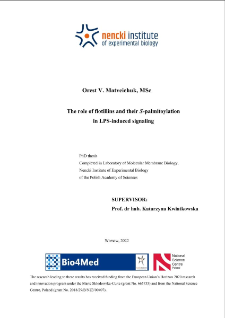
Object
Title: The role of flotillins and their S-palmitoylation in LPS-induced signaling : PhD thesis
Institutional creator:
Instytut Biologii Doświadczalnej im. Marcelego Nenckiego PAN
Contributor:
Kwiatkowska, Katarzyna (1962- ) : Supervisor
Publisher:
Nencki Institute of Experimental Biology PAS
Place of publishing:
Description:
125 pages : illustrations ; 30 cm ; Bibliography ; Summary in Polish
Degree grantor:
Instytut Biologii Doświadczalnej im. Marcelego Nenckiego PAN
Type of object:
Abstract:
Flotillin-1 and flotillin-2 are ubiquitously expressed proteins which are N-myristoylated and/or S-palmitoylated. Thanks to these acylations, flotillins bind to the cytoplasmic leaflet of plasma membrane nanodomains, rafts. Moreover, flotillins undergo homo- and hetero-oligomerization and interact with numerous proteins. Therefore, flotillins can act as scaffolding proteins, facilitating the assembly of multiprotein submembrane complexes involved in various cellular processes.The main objective of this study was to reveal the role of flotillins and their S-palmitoylation in TLR4 signaling triggered by bacterial lipopolysaccharide (LPS). TLR4 initiates a pro-inflammatory response aiming at the eradication of bacteria which can lead to fatal sepsis, fueling interest in TLR4 signaling. The rationale for undertaking the studies was: (1) results of our mass spectrometry analysis, which showed that the amount of palmitoylated flotillin-1 increased in LPS-stimulated Raw264 macrophage-like cells, suggesting its participation in LPS-triggered signaling; (2) a line of data indicating that flotillins are involved in endocytosis and cellular trafficking of raft proteins. A typical raft protein is CD14 which assists activation of TLR4 by LPS. It was assumed that flotillins can affect LPS-induced signaling due to possible interplay with CD14.To achieve the goal, lentiviral particles were used to deliver flotillin-2-specific shRNA into Raw264 cells. Several clones of cells stably depleted of flotillin-2 were obtained, which were also found to be deficient in flotillin-1. In flotillin-depleted cells, the LPS-induced responses were diminished. The TRIF-dependent signaling pathway of TLR4 leading to activation of the IRF3 transcription factor was inhibited and the subsequent production of chemokine CCL5/RANTES was reduced. The MyD88-dependent signaling leading to the activation of the NFκB transcription factor and production of cytokine TNFα was also reduced. However, the latter effect was most pronounced in cells stimulated with low LPS concentration which requires the participation of CD14. Indeed, depletion of flotillin-1 and -2: (i) lowered CD14 mRNA level; (ii) reduced the total cellular level of CD14; (ii) decreased the amount of CD14 on the cell surface. Notably, no such changes were observed for TLR4. On the other hand, forced clustering of CD14 in the plasma membrane (the first effect of LPS binding) induced S-palmitoylation of flotillin-1 and flotillin-2, indicating mutual interactions of flotillins and CD14. Co-expression of flotillins with 23 members of the zDHHC family revealed that zDHHC5 and zDHHC8 can S-palmitoylate flotillins. After silencing of Zdhhc5 or Zdhh8, it was found that zDHHC5 participation is required for a response to LPS triggered in both TLR4 signaling pathways, with emphasis on the TRIF-dependent pathway, which may be linked with zDHHC5 involvement in S-palmitoylation of flotillins. Taken together, the data indicate that flotillins modulate the cellular level of CD14 and interact (indirectly) with CD14, thereby affecting the intensity of the LPS-induced pro-inflammatory response. Flotillins are likely to be involved in CD14 endocytosis and recycling, as well as in the transport of newly synthesized CD14 to the plasma membrane, all events may be regulated by S-palmitoylation of flotillins catalyzed among others by zDHHC5. The above results were obtained, i.a., owing to the development of a modification of a technique for detecting palmitoylated protein. It involves enrichment of 17ODYA (palmitic acid analogue)-labeled proteins and their recovery from streptavidin-coupled beads allowing simultaneous identification of several endogenous and overproduced palmitoylated proteins. The technique was used in a study conducted in collaboration with the Institute of Molecular Genetics ASCR in Prague and allowed the detection of S-palmitoylation of OPAL1, an adaptor protein of leukocytes, likely to be located in rafts.
Detailed Resource Type:
Resource Identifier:
Source:
Language:
Language of abstract:
Digitizing institution:
Nencki Institute of Experimental Biology of the Polish Academy of Sciences
Original in:
Library of the Nencki Institute of Experimental Biology PAS
Access:
Object collections:
- Nencki Institute of Experimental Biology PAS
- Nencki Institute of Experimental Biology PAS > Dissertations
- Nencki Institute of Experimental Biology PAS > Dissertations > PhD Thesis
Last modified:
Dec 21, 2023
In our library since:
Oct 10, 2022
Number of object content downloads / hits:
62
All available object's versions:
https://rcin.org.pl/ibd/publication/272891
Show description in RDF format:
Show description in RDFa format:
Show description in OAI-PMH format:
| Edition name | Date |
|---|---|
| Matveichuk, Orest V.,2022, The role of flotillins and their S-palmitoylation in LPS-induced signaling : PhD thesis | Dec 21, 2023 |

 INSTYTUT ARCHEOLOGII I ETNOLOGII POLSKIEJ AKADEMII NAUK
INSTYTUT ARCHEOLOGII I ETNOLOGII POLSKIEJ AKADEMII NAUK
 INSTYTUT BADAŃ LITERACKICH POLSKIEJ AKADEMII NAUK
INSTYTUT BADAŃ LITERACKICH POLSKIEJ AKADEMII NAUK
 INSTYTUT BADAWCZY LEŚNICTWA
INSTYTUT BADAWCZY LEŚNICTWA
 INSTYTUT BIOLOGII DOŚWIADCZALNEJ IM. MARCELEGO NENCKIEGO POLSKIEJ AKADEMII NAUK
INSTYTUT BIOLOGII DOŚWIADCZALNEJ IM. MARCELEGO NENCKIEGO POLSKIEJ AKADEMII NAUK
 INSTYTUT BIOLOGII SSAKÓW POLSKIEJ AKADEMII NAUK
INSTYTUT BIOLOGII SSAKÓW POLSKIEJ AKADEMII NAUK
 INSTYTUT CHEMII FIZYCZNEJ PAN
INSTYTUT CHEMII FIZYCZNEJ PAN
 INSTYTUT CHEMII ORGANICZNEJ PAN
INSTYTUT CHEMII ORGANICZNEJ PAN
 INSTYTUT FILOZOFII I SOCJOLOGII PAN
INSTYTUT FILOZOFII I SOCJOLOGII PAN
 INSTYTUT GEOGRAFII I PRZESTRZENNEGO ZAGOSPODAROWANIA PAN
INSTYTUT GEOGRAFII I PRZESTRZENNEGO ZAGOSPODAROWANIA PAN
 INSTYTUT HISTORII im. TADEUSZA MANTEUFFLA POLSKIEJ AKADEMII NAUK
INSTYTUT HISTORII im. TADEUSZA MANTEUFFLA POLSKIEJ AKADEMII NAUK
 INSTYTUT JĘZYKA POLSKIEGO POLSKIEJ AKADEMII NAUK
INSTYTUT JĘZYKA POLSKIEGO POLSKIEJ AKADEMII NAUK
 INSTYTUT MATEMATYCZNY PAN
INSTYTUT MATEMATYCZNY PAN
 INSTYTUT MEDYCYNY DOŚWIADCZALNEJ I KLINICZNEJ IM.MIROSŁAWA MOSSAKOWSKIEGO POLSKIEJ AKADEMII NAUK
INSTYTUT MEDYCYNY DOŚWIADCZALNEJ I KLINICZNEJ IM.MIROSŁAWA MOSSAKOWSKIEGO POLSKIEJ AKADEMII NAUK
 INSTYTUT PODSTAWOWYCH PROBLEMÓW TECHNIKI PAN
INSTYTUT PODSTAWOWYCH PROBLEMÓW TECHNIKI PAN
 INSTYTUT SLAWISTYKI PAN
INSTYTUT SLAWISTYKI PAN
 SIEĆ BADAWCZA ŁUKASIEWICZ - INSTYTUT TECHNOLOGII MATERIAŁÓW ELEKTRONICZNYCH
SIEĆ BADAWCZA ŁUKASIEWICZ - INSTYTUT TECHNOLOGII MATERIAŁÓW ELEKTRONICZNYCH
 MUZEUM I INSTYTUT ZOOLOGII POLSKIEJ AKADEMII NAUK
MUZEUM I INSTYTUT ZOOLOGII POLSKIEJ AKADEMII NAUK
 INSTYTUT BADAŃ SYSTEMOWYCH PAN
INSTYTUT BADAŃ SYSTEMOWYCH PAN
 INSTYTUT BOTANIKI IM. WŁADYSŁAWA SZAFERA POLSKIEJ AKADEMII NAUK
INSTYTUT BOTANIKI IM. WŁADYSŁAWA SZAFERA POLSKIEJ AKADEMII NAUK
































